Module-1
Laplace Transform
Question-1: Define Laplace transform and its conditions for existence.
Sol.
Let f(t) be any function of t defined for all positive values of t. Then the Laplace transform of the function f(t) is defined as-

Provided that the integral exists, here ‘s’ is the parameter that could be real or complex.
The inverse of the Laplace transform can be defined as below-

Here 
f(t) is called the inverse Laplace transform of 
L is called the Laplace transformation operator.
Conditions for the existence of Laplace transform-
The Laplace transform of f(t) exists for s>a, if
1. f(t) is a continuous function.
2.  is finite
is finite
Question-2: Find the Laplace transform of the following function-

Sol.
Here 
So that we can write it as-

Now-

Question-3: Find the Laplace transform of (1 + cos 2t)
Sol. 




So that-

Question-4: define the first shifting property of Laplace transform
Sol.
(Theorem)- If 

Proof: By definition-

Let (s – a) = r

Hence proved.
Question-5: Find the Laplace transform of 
Sol. Here-

So that-




As we know that- 
So that-


Hence-

Question-6: Find the Laplace transform of the following function-

Sol. The given function f(t) can be written as-

So, by definition,



Question-7: Find the Laplace transform of  .
.
Sol. Here-


Now-

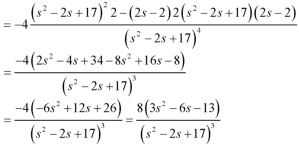
Question-8: using Laplace transform find the solution to the following initial value problem-
y’ + y = 
Sol. On taking the Laplace transform and using the initial conditions, we get-

Thus

On breaking into partial fractions, we get-



Question-9: Express the function given below in terms of a unit step function and find it's Laplace transform as well-

Sol. Here we are given-




So that-

Question-10: Evaluate-
1. 

Sol.1. As we know that- 
So that-

2. As we know that-



Question-11: Find the inverse Laplace transform of-

Sol.



Question-12: Find 
Sol.



Question-13: Use Laplace transform method to solve the following equation-

Sol. Here we have-

Take Laplace transform of both sides, we get-

It becomes-
(
So that-

Now breaking it into partial fractions-

We get the following results on inversion-


Question-14: solve the following differential equation by using Laplace transform-


Here D = d/dt and 
Sol.
Here we have-


Now multiply (1) by D+1 and (2) by D – 1 we get-


Now subtract (4) from (3), we get-



By taking Laplace to transform we get-




Put the value of  in (1) we get-
in (1) we get-

By taking Laplace to transform we get-

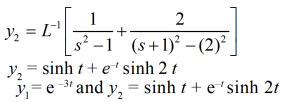
Which is the required answer.
Module-1
Laplace Transform
Question-1: Define Laplace transform and its conditions for existence.
Sol.
Let f(t) be any function of t defined for all positive values of t. Then the Laplace transform of the function f(t) is defined as-

Provided that the integral exists, here ‘s’ is the parameter that could be real or complex.
The inverse of the Laplace transform can be defined as below-

Here 
f(t) is called the inverse Laplace transform of 
L is called the Laplace transformation operator.
Conditions for the existence of Laplace transform-
The Laplace transform of f(t) exists for s>a, if
1. f(t) is a continuous function.
2.  is finite
is finite
Question-2: Find the Laplace transform of the following function-

Sol.
Here 
So that we can write it as-

Now-

Question-3: Find the Laplace transform of (1 + cos 2t)
Sol. 




So that-

Question-4: define the first shifting property of Laplace transform
Sol.
(Theorem)- If 

Proof: By definition-

Let (s – a) = r

Hence proved.
Question-5: Find the Laplace transform of 
Sol. Here-

So that-




As we know that- 
So that-


Hence-

Question-6: Find the Laplace transform of the following function-

Sol. The given function f(t) can be written as-

So, by definition,



Question-7: Find the Laplace transform of  .
.
Sol. Here-


Now-

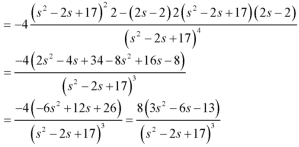
Question-8: using Laplace transform find the solution to the following initial value problem-
y’ + y = 
Sol. On taking the Laplace transform and using the initial conditions, we get-

Thus

On breaking into partial fractions, we get-



Question-9: Express the function given below in terms of a unit step function and find it's Laplace transform as well-

Sol. Here we are given-




So that-

Question-10: Evaluate-
1. 

Sol.1. As we know that- 
So that-

2. As we know that-



Question-11: Find the inverse Laplace transform of-

Sol.



Question-12: Find 
Sol.



Question-13: Use Laplace transform method to solve the following equation-

Sol. Here we have-

Take Laplace transform of both sides, we get-

It becomes-
(
So that-

Now breaking it into partial fractions-

We get the following results on inversion-


Question-14: solve the following differential equation by using Laplace transform-


Here D = d/dt and 
Sol.
Here we have-


Now multiply (1) by D+1 and (2) by D – 1 we get-


Now subtract (4) from (3), we get-



By taking Laplace to transform we get-




Put the value of  in (1) we get-
in (1) we get-

By taking Laplace to transform we get-
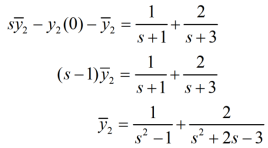
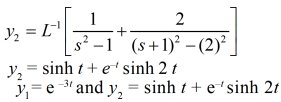
Which is the required answer.
Module-1
Module-1
Laplace Transform
Question-1: Define Laplace transform and its conditions for existence.
Sol.
Let f(t) be any function of t defined for all positive values of t. Then the Laplace transform of the function f(t) is defined as-

Provided that the integral exists, here ‘s’ is the parameter that could be real or complex.
The inverse of the Laplace transform can be defined as below-

Here 
f(t) is called the inverse Laplace transform of 
L is called the Laplace transformation operator.
Conditions for the existence of Laplace transform-
The Laplace transform of f(t) exists for s>a, if
1. f(t) is a continuous function.
2.  is finite
is finite
Question-2: Find the Laplace transform of the following function-

Sol.
Here 
So that we can write it as-

Now-

Question-3: Find the Laplace transform of (1 + cos 2t)
Sol. 




So that-

Question-4: define the first shifting property of Laplace transform
Sol.
(Theorem)- If 

Proof: By definition-

Let (s – a) = r

Hence proved.
Question-5: Find the Laplace transform of 
Sol. Here-

So that-




As we know that- 
So that-


Hence-

Question-6: Find the Laplace transform of the following function-

Sol. The given function f(t) can be written as-

So, by definition,



Question-7: Find the Laplace transform of  .
.
Sol. Here-


Now-

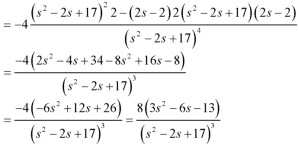
Question-8: using Laplace transform find the solution to the following initial value problem-
y’ + y = 
Sol. On taking the Laplace transform and using the initial conditions, we get-

Thus

On breaking into partial fractions, we get-



Question-9: Express the function given below in terms of a unit step function and find it's Laplace transform as well-

Sol. Here we are given-




So that-

Question-10: Evaluate-
1. 

Sol.1. As we know that- 
So that-

2. As we know that-



Question-11: Find the inverse Laplace transform of-

Sol.



Question-12: Find 
Sol.



Question-13: Use Laplace transform method to solve the following equation-

Sol. Here we have-

Take Laplace transform of both sides, we get-

It becomes-
(
So that-

Now breaking it into partial fractions-

We get the following results on inversion-


Question-14: solve the following differential equation by using Laplace transform-


Here D = d/dt and 
Sol.
Here we have-


Now multiply (1) by D+1 and (2) by D – 1 we get-


Now subtract (4) from (3), we get-



By taking Laplace to transform we get-




Put the value of  in (1) we get-
in (1) we get-

By taking Laplace to transform we get-
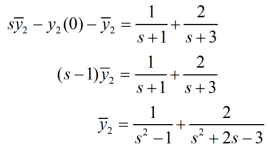
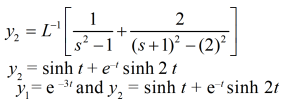
Which is the required answer.